Search Results
Fine Jewelry University Articles matching: “Gem in the Spotlight”
Showing only FJU Article results. Click here to show all results.
Fine Jewelry University (Show All FJU Articles)
-

Gem in the Spotlight: Topaz
The old baseball joke, “Who’s on First?” “Yes, Who’s on First…” always comes to mind when I hear people discussing Topaz…love Topaz; it reminds me of a blue sky.” Then her friend says back, “Topaz may be like a golden sunset, but not the sky.” A third friend will chime in, “You’re both crazy, it’s like a beautiful peach.” Then, a passerby contributes, “You…course, all of them are right. History and Lore Topaz in its pure form is naturally colorless, clear like a diamond. The famous “Braganza Diamond” was thought to be the largest diamond ever found (prior to the Cullinan Diamond) at 1,680 …
-
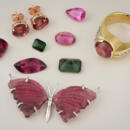
Gem in the Spotlight: Tourmaline
Tourmaline is one of the most beautiful gems that you’ve probably never heard of. Less popular than the likes of ruby or sapphire, tourmaline… any color you can imagine, and people have most likely used and appreciated it for hundreds of years. But, before the advent of modern gemology, most tourmaline was believed to be ruby, sapphire, or emerald. Gemology of Tourmaline … and not a species or member of a different family (unlike emerald and aquamarine, for example, which are members of the beryl family). It has a refractive index of 1.624 to 1.644 and a Mohs hardness of 7 to 7.5 which makes it softer …
-
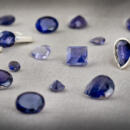
Gem in the Spotlight: Iolite
Iolite is maybe not the first gemstone people think of for their blue-violet jewelry, but it should be near the top of the list. Iolite’s … sapphire, tanzanite, and amethyst. They may have name recognition, but iolite has a rich, unique color and great gem value on its side. It is more subtlety nuanced than amethyst and deeper than many tanzanites. Iolite’s name comes from … word “ios” meaning violet. Unlike many other popular gems, iolite cannot be heat treated to enhance its color. The color you see is the natural color of the stone when it was first discovered. This adds value to many gem buyers who don’…
-
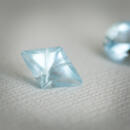
Gem in the Spotlight: Aquamarine
Aquamarine derives its name from the Latin which literally means “seawater,” a tribute to its beautiful blue color. As a member of the beryl family, … with tranquility and happiness, aquamarine was also thought to instill courage, cure laziness, and sharpen the intellect. The ancient Greeks used aquamarine often in jewelry believing it captured the true spirit of the sea. aquamarine … known for its beautiful blue color, aquamarine was used to bring happiness, eternal youth, and control passion. In the body, aquamarine was thought to reduce swelling, prevent convulsions, heal liver ailments, calm nerves, and …
-
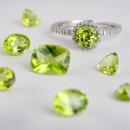
Gem in the Spotlight: Peridot
Peridot is a lovely yellow-green gem with a rich history. Legend has it that Peridot was the favorite gemstone of Cleopatra. The ancients called it the “…It was believed that peridot could chase away evil spirits and dissolve curses but only when set in gold. Peridot is the birthstone for August. It is also the accepted anniversary gemstone for the 16th year of marriage. Peridot’s unique …’s color ranges from yellow-green to a warm olive green, and it is distinguished by its soft appearance. Color is the most important characteristic when determining the value of a Peridot gem. The deeper green the peridot is, the higher …
-
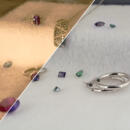
Gem in the Spotlight: Alexandrite
… expensive than diamond and more illustrious than sapphire, emerald, or even ruby, alexandrite has been known around the world as one of the most sought-after gems for the better part of 200 years. But, what makes this stone so special? …LED light. Under incandescent light, candle, and firelight, alexandrite appears purplish-red. This is because of how the trace element chromium interacts with alexandrite’s crystal structure. It absorbs most wavelengths of light very …
-
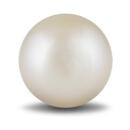
Gem in the Spotlight: Pearl
Pearls have captured the imagination and adoration of people from diverse backgrounds throughout history. They are both simple and infinitely…, and lore surrounding this most unique gem. How Are Pearls Formed? Pearls are formed when a foreign object enters the shell of a mollusk and irritates the soft mantle tissue within. In response to the irritant, the mollusk secretes a … called nacre to coat the object and protect itself. Over time, layer upon layer of nacre is deposited around the irritant, eventually forming a pearl. This process can occur naturally or via human intervention. Natural pearls grow in …
-
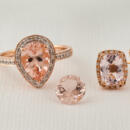
Gem in the Spotlight: Morganite
Morganite is a beautiful, soft pink gemstone and a graceful expression of elegance. It is not a very well-known gem, but it definitely should be. It is … and known for its transparent peach-pink hue though it also occurs as soft pink, violet-pink, or pale salmon. It is the subtle, understated nature of Morganite’s color that sets it apart from many of the more popular gemstones. … as emerald and aquamarine. Because of its association with emerald it is sometimes called “Pink Emerald”. Other names for Morganite are “Pink Beryl”, “Rose Beryl”, and “Cesian (or caesian ) Beryl”. “Cesian” refers to the presence of the…
-
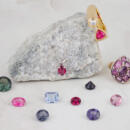
Gem in the Spotlight: Spinel
Spinel, the Great Imposter” sounds like the title of an action movie, but it could also be the title of this article. For years … today is often used as a substitute for similar looking stones. In recent years, spinel has started to move out of the shadows and be appreciated in its own right, and we can see why. Its colors rival even the best rubies, sapphires, …, and other more popular gems. For only the 3rd time in the last one hundred years, the industry is modifying the official birthstone list. Spinel will be joining peridot as the August birthstone! This change was officially made in 2016…